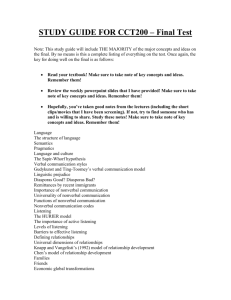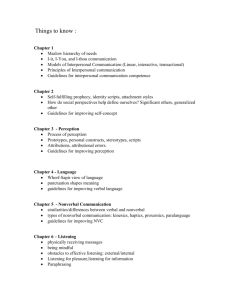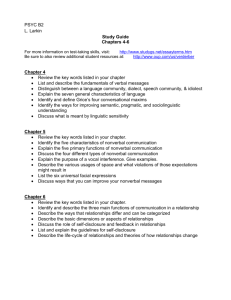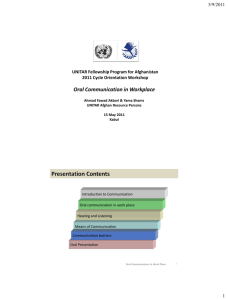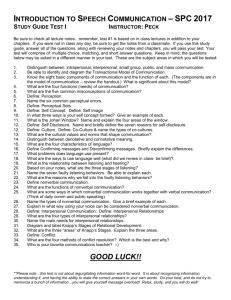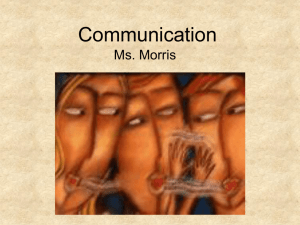Communication
advertisement
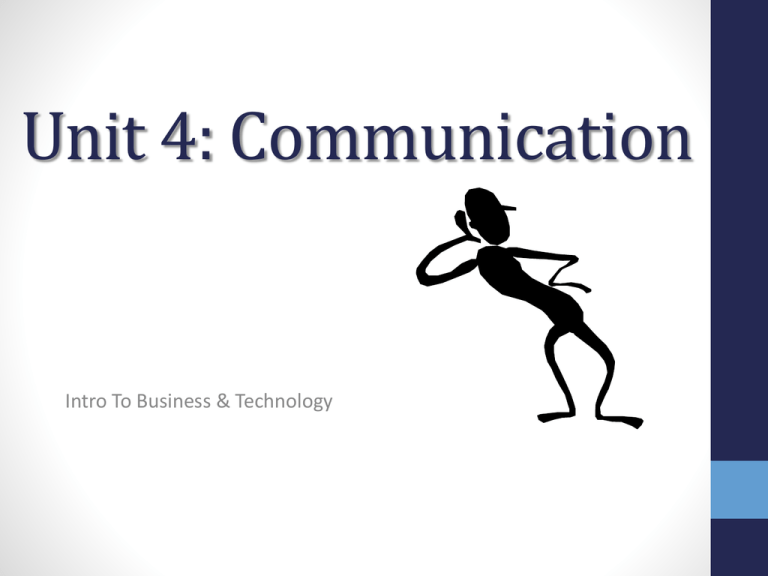
Unit 4: Communication Intro To Business & Technology Standards • BMA-IBT-1: Demonstrate employability skills required by business and industry. • BMA-IBT-2: Apply technology as a tool to increase productivity and to create, edit, and publish industry appropriate documents. • BMA-IBT-3: Master word processing software to create, edit, and publish professional-appearing business documents. • BMA-IBT-6: Use professional oral, written, and digital communication skills to create, express, ad interpret information and ideas. • BMA-IBT-10: Explain the goals, mission, and objectives of Future Business Leaders of America. Explain how participation in career and technology education student organizations can promote lifelong responsibility for community service and professional development. Essential Questions • What are the elements of the communication process? (message, sender, receiver, channel, and feedback) • What is the purpose of business communication? • What are some types of business communication? • Why are goodwill and positive image important for business success? • Communication is the process used to send and interpret messages so that they are understood. • Communication is important in that it allows people to share ideas, ask questions, and enjoy artistic works such as a poem or movie. • Communication is important in the workplace in order to make progress and complete an assigned task or goal. • Without communication, people would not be able to share information and work together to perform daily activities. Elements in the Communication Process Each element in the communication process is important. Message Composed of a set of symbols, such as words or gestures Sender Person who creates and shares a message Receiver Person who hears and reads and interprets a message Channel Mode used to send a message, e.g., letter or speaking Feedback Response of a receiver to a message Purpose of Communication • Business communication is sending and interpreting messages related to products, services, or activities of a company or organization. Effective communication is important for business success. Purpose • Obtain and share information – information is one of the most valuable resources people and companies have. • Build good will and image. Goodwill is a positive feeling or attitude toward others. In business, it refers to the good reputation or positive image of a company. • Persuade – convince others to adopt an opinion or take a certain action. • Build relationships an self-esteem Types of Business Communication • Internal communication are messages to people within the company. • Messages created within the company and sent to people outside the company are external communication. • Communication within a company can be formal or informal. • Grapevine (office gossip) is informal communication which is repeating rumors about coworkers and business affairs may be unethical. • Downward communication travels from managers to employees downward communications. • Upward communication refers to messages from workers to managers of the company. • Written communication – is often the best channel for a message; provides a written record of information exchanged; allows retrieval and referral of message. • Oral communication – is the fastest providing immediate feedback to the sender. Face-to-face and telephone. •Verbal (face to face, phone, and in writing (using words) •Non Verbal (eye contact, posture, personal appearance, and timing) Communication Barriers • Communication barriers are things or conditions that interfere with communication. Learning to recognize these barriers can help you overcome them. • External communication barriers – conditions outside that hinder communication e.g., poor lighting, heat or cold, humidity, uncomfortable seating, noises. • Internal barriers – conditions within the receiver or sender that hinder communication e.g., educational background, lack of motivation or interest Receivers' duties to improve communication: • Reading – process of seeing and interpreting written words and other symbols. Focusing and ensuring understanding are the keys to effective reading. • Listening – process of hearing and focusing attention to understand an oral message. Diversity at Work • Diversity refers to the presence of a wide range of variation in qualities or attributes of people of things e.g., race, gender, age, and disability now included are ethnicity, culture, background, and personality. • A diverse workforce makes employers better able to meet the needs of growing global markets and an increasingly diverse U.S. population. • Diversity is one of the greatest challenges including communication in today’s workforce. • Language, body language, and personal space are all communication barriers especially when it comes to cultural diversity. • Etiquette – a set of rules and behaviors for a particular place or situation. • Customs – beliefs, traditions, and practices of a group of people. • Customs and etiquette may vary from country to country so as employers/employees we must be sensitive to these things in todays work environments. • Stereotype – an oversimplified belief about a group of people; can lead to judging people as a member or group rather than an individual. • Prejudice – a bias that prevents objective thought about a person or thing. Prejudice can hinder communication. • Having a professional attitude can reduce barriers to communication. • This includes: • Refrain from making judgments about others • Keeps an open mind • Does not make assumptions or jump to conclusions • Keeps emotions in check • Is slow to take offense • Give others the benefit of the doubt Role of Nonverbal Communication • Nonverbal communication is composed of the messages sent without or in addition to words. Have a strong impact on receivers. • Spoke or written symbols are Verbal communication • Nonverbal symbols – body language, appearance, touch, space, time, and voice (exist in written and oral communication and in the environment) Nonverbal symbols affect spoken messages NONVERBAL SYMBOLS Body language Facial expressions, gestures, and posture Touching Shaking hands, back slapping, placing hand on someone’s shoulder, hugging Space The physical distance between individuals Time Being punctual for appointments or completing tasks by the date requested Paralanguage Qualities of voice (such as a pitch and volume), rate of speech, and actions (such as laughing or sighing) also includes laughing, crying, sighing, yawning, grunting, coughing Nonverbal symbols and your image • Your nonverbal communications are extremely important these include: • self-confidence (believe in yourself and abilities) • Too much self-confidence ( hinder and hurt your image; cocky, arrogant) • Too little self-confidence (seen as weak; negative thinking and unrealistic expectations) • Friendliness (being supportive, helpful or kind) Nonverbal symbols and your image • Enthusiasm (showing excitement or lively interest) • Sincerity ( being open, genuine, or earnest) • Appearance (critical to your image; being healthy, neat, clean, and appropriately dressed) • Eye contact (one of the most important nonverbal symbols; can send many messages of confidence or lack of interest) • Posture (way you stand or sit) Barriers to Effective Listening • Attitudes About the Speaker • Attitudes About the Topic • Prejudices or Differing Opinions • Assumptions • Environmental distractions • Physical Discomfort • Divided Focus Barriers to communication •Message not clear •Do not understand the message •Not listening •Lack of language skills Getting the message across • Always use appropriate tone when speaking • Make eye contact • Use appropriate body language • Make sure your audience is ready to listen Receiving messages (listening) •In order to comprehend a message you must be actively listening Active listening •Shows interest in the message •Do not be closed minded •Do not interrupt the messenger •Make eye contact with the messenger •Decrease distractions •Focus •After the speaker speaks, reinstate the message to ensure that you understand •Ask questions if you do not understand the message. Follow instructions • The elements of following instructions are very similar to listening • Make eye contact • Attempt to visualize the directions that speaker is giving •Ask questions or nod to let the speaker know that you are listening •Take notes •Repeat and reinstate directions Cell Phone & E-mail in the Workplace Unit 3 Communications Cell Phone Use in the Workplace • Turn off the ringer before entering the workplace. • Do not take personal calls during work hours • During breaks, find a private place if you must make or take a personal call. • If a cell phone is used for business reasons, make sure you have a professional sounding tone. • Never take a business or personal call if you are talking to a customer, client, employee or boss. • Avoid taking personal or business calls during meetings. • Avoid texting or reading text constantly while sitting with another employee, customer, client, or boss. • Avoid texting or reading during meetings. E-mail • E-mail (electronic mail) is an informal message written, sent, and received on a computer. • E-mails are a major form of communication in the workplace. • Employees often consider e-mail informal, and may include comments that could come back to haunt the company. • In essence, you may want to think twice about sending a dirty joke to a coworker or using inappropriate language that may offend another employee or anyone inside and outside the workplace. Your workplace e-mail should cover certain basic principles: • E-mail should be professional and courteous. • E-mail must not contain any illegal, libelous, or offensive statements. • All statements meant to harass — sexually or otherwise — are prohibited. • E-mail is for business purposes, not for personal use. • All e-mail is company property. • The company has the right to access e-mail sent to or from every computer. • The company has the right to retrieve email stored on its servers that users have deleted from their e-mail programs. • Employees who violate the e-mail policy will be subject to disciplinary measures or termination. E-mail Netiquette • Netiquette – a set of formal guidelines for behaving courteously online. • Using netiquette when composing and sending messages shows consideration for the receiver. • Do not send flames (angry or insulting messages) • Do not use all capital letters when keying e-mail messages (indicates shouting) • Do not use e-mail to send confidential or sensitive information or to communicate personal criticism. • Do not use emoticons in business emails. An emoticon is a combination of keyboard characters or icons used in messages to indicate emotion (ex. Smiley face) • Use correct grammar, spelling, and punctuation. Do not use informal abbreviations, such as TTYL for talk to you later. Instant Messaging • Instant messaging (IM) is a means of communicating electronically via text messages with one or more people in real time. • Rule 1: Follow company policy. If your company doesn’t have an IM policy, then use common sense as your guide. • Rule 2: Be professional. Refrain from badmouthing your co-workers, company or clients, or sharing too much personal information. • Rule 3: Keep confidential information confidential. Don’t send confidential business information over IM. • Because IM technology tends to be unsecured, with the added possibility that a public IM provider bypasses your company network security, it is all too easy for hackers to access your old conversation logs. • Rule 4: Don’t mix business with pleasure. Many people have their friends and family on the same IM interface –Yahoo, Gtalk and MSN are popular providers – as their business contacts. • During work hours, refrain from chatting with your personal contacts. • Rule 5: Be aware that instant messages can be saved. Making bold statements about individuals are not always deleted. In essence, someone can copy and paste your entire conversation onto a Notepad or Word document. Some IM services allow you to archive entire messages. Bottom line: Be careful what you say, just as you would in an e-mail. • 8. DON'T: Share personal data or information through instant messaging. (e.g., password or credit card number information, phone numbers). The text of your chat is relayed to a web server; hackers may be online even in instant messaging. Workplace Relationships • Leadership is providing guidance and inducing others to act. This is a vital skill that employees seek. • Teamwork is one or more people acting together to achieve a goal. Teamwork involves communication. • Synergy allows the team to be more creative and productive than the individuals will be working separately. • Virtual team –one with members who do not share a physical workspace working together using communications technology, such as telephone and e-mail. Guidelines for Team Success • Identify the goals of the team. • Determine tasks or steps needed to accomplish goals. • Identify resources needed to complete the tasks. • Assign duties ad task to team members. • Communicate regularly. • Resolve conflicts that arise. • Brainstorm ideas for solving problems that arise. • Evaluate procedures • Celebrate success! Leaders….. • Leaders are committed to their work. (they show initiative and discipline) • Leaders have integrity. (honest and live by high ethical standards) • Leaders are enthusiastic. • Leaders have self-confidence and inspire others to trust them. • Leaders care about others. They have good communication and teamwork skills.


